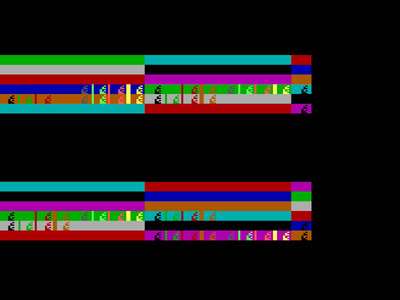First post, by clb
While testing out different ISA VGA cards, I find that some cards have a really peculiar video mode 0Ah in their BIOS, which produces a seemingly broken crazy high 178 Hz refresh rate video mode.
At first I thought that this was just some quirk of one VGA card, but now in my tests, I am seeing that several graphics cards from different manufacturers produce this same video mode when activating mode 0Ah via INT 10h. These include:
- WD90C30-LR, pictured in (ViewTOP) WD90C30-LR ISA VGA DIP switches: play DOS games at 90hz refresh rate
- CL-GD5422,
- Nokia/Paradise PVGA1A-JK,
- Everex Viewpoint EV628/AVGA1
- Ahead V5000
and maybe others. The following cards have been tested NOT to have this video mode:
- Trident 8900C and 8900D,
- CL-GD5428,
- Diamond SpeedStar 24 (Tseng ET4000AX),
- Oak OTI037C,
- Video 7 VGA 1024i/Headland HT208
This mode has the following parameters, as measured from WD90C30-LR:
Pixel clock: 25.257799 MHz,
Hsync: 46.774 kHz,
Vsync: 178.526 Hz,
Horizontal total: 540 pixels,
Vertical total: 262 lines,
Active screen size: 198x246 pixels
Horizontal: 4 px front porch, 36 px hsync, 302 px back porch
Vertical: 1 line front porch, 3 lines vsync, 12 lines back porch
When I fill the video memory in segments A000h-AFFFh and B000h-BFFFh with increasing bytes (e.g. memory index i in the segment gets byte value i), I get this mode to produce the following kind of video output, as shown in the attached screenshot. However what is strange about this is that I need to do the video memory fill *before* entering this mode, or otherwise the writes will not show up on screen.
In other words, if I first enter the video mode 0Ah, then fill up both segments A000h and B000h with test bits, the screen will end up staying blank. But if I first enter video mode 07h, then do the fill, then the image pattern will show up.
All this makes me think this is that this is some kind of "broken" mode to some effect. Although what makes me still ponder about this, is that:
a) multiple cards have this exact same behavior, as if it was intentional design somehow, and
b) these cards I have tested generally don't seem to have many broken video mode ID numbers, most ID numbers that are not associated with a mode, will generally fail to set anything, and querying the current active video mode will not change. But not in this case.
This mode is some kind of 16 colors text mode, some of the "characters" have the blink bit on.
Searching for this mode 0Ah on the web, I only find mentions about a 640x200 PCjr/Tandy video mode in that mode number slot, but this is definitely not it.
On the WD90C30-LR card from this thread, this mode changes to a hilarious 224 Hz vsync, 58.6 kHz hsync rate when DIP5 is set to be enabled. I can't recall what exactly caused the most strain on old CRTs, but this could be quite the CRT monitor torturer for anyone who dislikes CRTs.
Anyone has any clues? 😀
